It looks like you're using an Ad Blocker.
Please white-list or disable AboveTopSecret.com in your ad-blocking tool.
Thank you.
Some features of ATS will be disabled while you continue to use an ad-blocker.
share:
originally posted by: beansidhe
a reply to: peter vlar
Wow. If they had red ochre, flowers in the grave and a sense of the afterlife, then to go back to Shiloh's point, they must have spoke to each other. They must have had language, not only to comunicate with each other but also to process internally the concept of an otherworld.
It's pretty safe to say that they had speech and language with similar capabilities as our own. This isn't random guesswork, it's based on a Neanderthal Hyoid bone recovered. Thanks to technology, a model derived from a 3D X-Ray scan has been crafted and tested to see if it would act the same way as the hyoid in modern humans. It was the same shape but prior to the 3D scan, there was no way to know for certain how the hyoid would act in conjunction with the other surrounding bones. The final verdict was that it did in fact operate just as "ours" does, giving them the same range of speech and sounds that we use today. In order for them to hunt the way they did, or help the injured man found in Shanidar cave, they would have had to be able to communicate and express abstract thoughts and concepts to one another, especially so if they were to amputate a portion of an arm and have the person survive the surgery.
www.sciencedaily.com...
www.bbc.com...
And to survive that long with his inuries, yes he must have been cared for. Someone must have brought him food at the very, very least.
So we learned from Neanderthals? Or shared ideas with them.
It was a definite exchange of ideas back and forth. They shared some with us, we shared some with them. Either way, each species benefited from its contact with the other.
www.sciencedaily.com...
I remember reading somewhere that some Australian stories could be around 40,000 years old - passed down through families. It just makes me wonder if we're still telling Neanderthal stories today?
Thanks for your input by the way, it is most gratefully received.
Technically, in Australian Aboriginal stories and traditions, it would be a reference to Denisovans as opposed to Neanderthal. However, as some of the oldest civilizations in the world are, for all intents and purposes, at the crossroads of where HSS was moving into Europe and Asia(The Levant, Turkey, Iraq) it is entirely possible that oral traditions were passed down for thousands of years and were referring to Neanderthal and over time fell victim to the most legthy version of the telephone game in history.
edit on 14-3-2015 by peter vlar because: (no reason given)
a reply to: peter vlar
I can't believe you can find evidence that Neanderthals would have spoke! That's amazing! I wonder what their accent was like, or if they sang?
I've been googling Neanderthals these last few days, only to give myself a headache. It would appear that they may have descended from homo heidelbergensis who was living about 700,000-200,000 years ago. (News to me, but you might already know this. In fact, I suspect you do!).
Smithsonian
And from wiki (font of all wisdom):
Well it's a leap, but it's a tempting leap, and not without good reason but if neanderthals could speak, could their ancestors probably not speak too? Paint, funerals... it's not impossible.
Aah, good point (Denisovans). Yes, stories of 'others' could have referred to memories of Neanderthals. I'm thinking of fairies and things like that. But then, could the neanderthals not have been telling stories of their ancestors?
Exactly!
Edit: I've just started on bone flutes now. So they could play music, maybe they could sing. I'm off to read more about these ancestors of mine.
I can't believe you can find evidence that Neanderthals would have spoke! That's amazing! I wonder what their accent was like, or if they sang?
I've been googling Neanderthals these last few days, only to give myself a headache. It would appear that they may have descended from homo heidelbergensis who was living about 700,000-200,000 years ago. (News to me, but you might already know this. In fact, I suspect you do!).
Smithsonian
In 2003, the Atapuerca team announced the discovery of a single stone handaxe found buried amongst the human remains in the Pit of Bones. According to the researchers, its strange colour may mark it out as evidence of the first funeral rite, which suggests the hominids at Atapuerca were deposited in the pit deliberately.
And from wiki (font of all wisdom):
No forms of art or sophisticated artifacts other than stone tools have been uncovered, although red ochre, a mineral that can be used to mix a red pigment which is useful as a paint, has been found at Terra Amata excavations in the south of France.
Well it's a leap, but it's a tempting leap, and not without good reason but if neanderthals could speak, could their ancestors probably not speak too? Paint, funerals... it's not impossible.
Technically, in Australian Aboriginal stories and traditions, it would be a reference to Denisovans as opposed to Neanderthal. However, as some of the oldest civilizations in the world are, for all intents and purposes, at the crossroads of where HSS was moving into Europe and Asia(The Levant, Turkey, Iraq) it is entirely possible that oral traditions were passed down for thousands of years and were referring to Neanderthal and over time fell victim to the most legthy version of the telephone game in history.
Aah, good point (Denisovans). Yes, stories of 'others' could have referred to memories of Neanderthals. I'm thinking of fairies and things like that. But then, could the neanderthals not have been telling stories of their ancestors?
the most lengthy version of the telephone game in history.
Exactly!
Edit: I've just started on bone flutes now. So they could play music, maybe they could sing. I'm off to read more about these ancestors of mine.
edit on 16-3-2015 by beansidhe because: eta
originally posted by: beansidhe
I can't believe you can find evidence that Neanderthals would have spoke! That's amazing! I wonder what their accent was like, or if they sang?
I've been googling Neanderthals these last few days, only to give myself a headache. It would appear that they may have descended from homo heidelbergensis who was living about 700,000-200,000 years ago. (News to me, but you might already know this. In fact, I suspect you do!).
Yes, they are extremely likely the descendants of H. Heidelbergensis, who in turn was a descendant of H. Antecessor. You may recall that a couple years ago, some ancient footprints were found on a shoreline in Britain. They belonged to H. Antecessor. I think its very possible if not likely that Neanderthal was able to sing. They demonstrate at some sites(though not all) jewelry as you point out in this thread, artwork and possibly religious practices so in my mind it's not a very far leap for them top have been singing. You might want to check out these 2 books for more insight into Neanderthals -
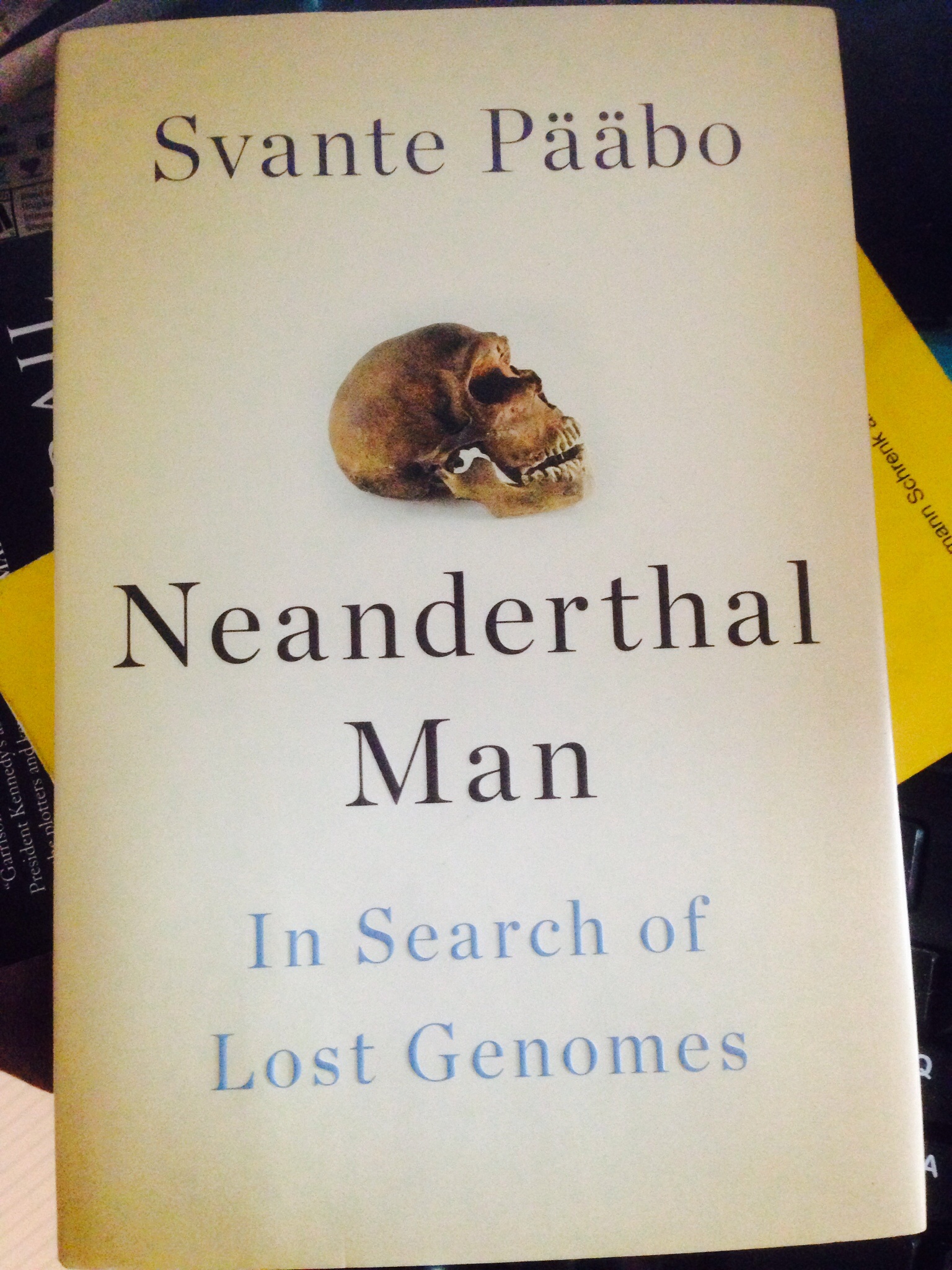
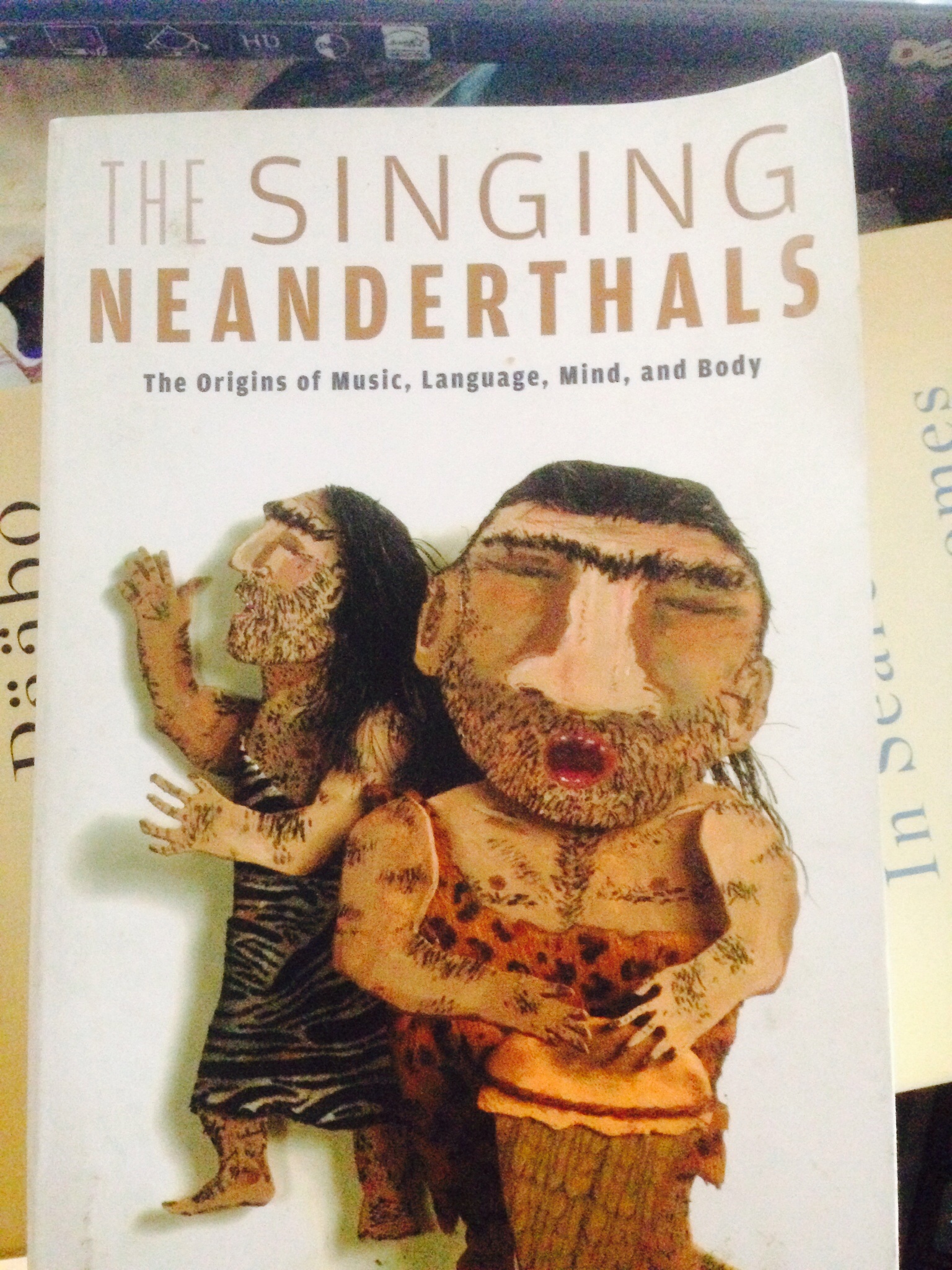
In 2003, the Atapuerca team announced the discovery of a single stone handaxe found buried amongst the human remains in the Pit of Bones. According to the researchers, its strange colour may mark it out as evidence of the first funeral rite, which suggests the hominids at Atapuerca were deposited in the pit deliberately.
Atapuerca is a gold mine in regards to our Pleistocene ancestors. Certainly one of the most important sites in Anthropology.
No forms of art or sophisticated artifacts other than stone tools have been uncovered, although red ochre, a mineral that can be used to mix a red pigment which is useful as a paint, has been found at Terra Amata excavations in the south of France.
Is the above quote specifically about Atapuerca? or is it a generalized statement regarding Neanderthal? There are many sites with artwork attributed to our long lost cousins. It's also potentially related to Neanderthal, its in the correct time frame but it also overlaps w/ HSS...the Lion Man of Hohlenstein Stadel.
Well it's a leap, but it's a tempting leap, and not without good reason but if neanderthals could speak, could their ancestors probably not speak too? Paint, funerals... it's not impossible.
Oh I definitely agree with you. In fact, it was recently discovered that Heidelbergensis was able to hear in the same range of frequencies as we do today and even if they could not speak, it's certainly an important step towards complex verbal communication.
Aah, good point (Denisovans). Yes, stories of 'others' could have referred to memories of Neanderthals. I'm thinking of fairies and things like that. But then, could the neanderthals not have been telling stories of their ancestors?
We shouldn't forget about H. Floresiensis as Australian Aborigines would probably have crossed paths with them as well as Denisovans and they could certainly have been the basis for some out there oral traditions!
a reply to: peter vlar
No! I refuse to believe you have that book!

Can I just pick anything Neanderthally and you can back it up? This is great, I love this thread! I'm going to check those books out (as soon as I finish the Star Mirror) very soon.
Aah, that's right, I remember that story. That was Heidelbergensis' antecedant? Wow. No, that was a general statement about Heidelbergensis, from a site in the South of France (red ochre statement) which I found very interesting.
Then they must have spoke - I bet they did. Och why wouldn't they, let's be honest? We're not so special! I start thinking about stories of old gods, who lived before humans and I'm sure that idea has been suggested before. I rarely have an original thought, lol. Maybe this is the basis of these tales.
Floresiensis! Now they would make the perfect basis for 'wee folk' stories. There's nothing new under the sun really, I'm starting to think?
No! I refuse to believe you have that book!

Can I just pick anything Neanderthally and you can back it up? This is great, I love this thread! I'm going to check those books out (as soon as I finish the Star Mirror) very soon.
Yes, they are extremely likely the descendants of H. Heidelbergensis, who in turn was a descendant of H. Antecessor. You may recall that a couple years ago, some ancient footprints were found on a shoreline in Britain. They belonged to H. Antecessor.
Aah, that's right, I remember that story. That was Heidelbergensis' antecedant? Wow. No, that was a general statement about Heidelbergensis, from a site in the South of France (red ochre statement) which I found very interesting.
Oh I definitely agree with you. In fact, it was recently discovered that Heidelbergensis was able to hear in the same range of frequencies as we do today and even if they could not speak, it's certainly an important step towards complex verbal communication.
Then they must have spoke - I bet they did. Och why wouldn't they, let's be honest? We're not so special! I start thinking about stories of old gods, who lived before humans and I'm sure that idea has been suggested before. I rarely have an original thought, lol. Maybe this is the basis of these tales.
Floresiensis! Now they would make the perfect basis for 'wee folk' stories. There's nothing new under the sun really, I'm starting to think?
originally posted by: beansidhe
a reply to: peter vlar
No! I refuse to believe you have that book!
Can I just pick anything Neanderthally and you can back it up? This is great, I love this thread! I'm going to check those books out (as soon as I finish the Star Mirror) very soon.
Pretty much lol Neanderthal were the topic of my abandoned masters thesis. I stopped working on it so I could become a rock n roll super star hahahaha
Aah, that's right, I remember that story. That was Heidelbergensis' antecedant? Wow. No, that was a general statement about Heidelbergensis, from a site in the South of France (red ochre statement) which I found very interesting.
I didn't think it was a specific statement regarding Atapuerco but I don't like to assume either.
Then they must have spoke - I bet they did. Och why wouldn't they, let's be honest? We're not so special! I start thinking about stories of old gods, who lived before humans and I'm sure that idea has been suggested before. I rarely have an original thought, lol. Maybe this is the basis of these tales.
I just came across some research that shows H. Heidelbergensis had a hyoid bone and was capable of speech 530,000 years BP, more than twice as old as was previously thought.
65.54.113.26...
Floresiensis! Now they would make the perfect basis for 'wee folk' stories. There's nothing new under the sun really, I'm starting to think?
I wouldn't be terribly shocked if we found other "little people" and their remains elsewhere. We have living Pygmy's in Africa so it isn't a massive stretch that there could have been others. Especially on some of the islands of the North Sea and the Irish Sea, perhaps Ireland itself hence the Leprechaun.
a reply to: peter vlar
You are both a rock and roll superstar and a neanderthal-fact superstar! And now you've gone and made my year!
From your link:
So...could their ancestors speak, then? Ok, I'll stop now but it begs the question...again!
I'll bet you're right, since Iceland and Scandanavia also have stories of wee trolls, elves - all the North Sea area does. 'The Northern Smalliensis' or somesuch could very well be the basis for these stories and the brilliant thing about that would be the age of the stories themselves! Well, that and finding another ancestor.
You are both a rock and roll superstar and a neanderthal-fact superstar! And now you've gone and made my year!
I just came across some research that shows H. Heidelbergensis had a hyoid bone and was capable of speech 530,000 years BP, more than twice as old as was previously thought.
From your link:
Modern hyoid morphology was present by at least 530kya and appears to represent a shared derived feature of the modern human and Neandertal evolutionary lineages inherited from their last common ancestor. Journal: Journal of Human Evolution - J HUM EVOL , vol. 54, no. 1, pp. 118-124, 2008
So...could their ancestors speak, then? Ok, I'll stop now but it begs the question...again!
I wouldn't be terribly shocked if we found other "little people" and their remains elsewhere. We have living Pygmy's in Africa so it isn't a massive stretch that there could have been others. Especially on some of the islands of the North Sea and the Irish Sea, perhaps Ireland itself hence the Leprechaun.
I'll bet you're right, since Iceland and Scandanavia also have stories of wee trolls, elves - all the North Sea area does. 'The Northern Smalliensis' or somesuch could very well be the basis for these stories and the brilliant thing about that would be the age of the stories themselves! Well, that and finding another ancestor.
edit on 17-3-2015 by beansidhe because: sp
a reply to: beansidhe
It is possible that earlier H. Erectus had some speech capabilities though to a lesser degree than HSS, HN or Denisovan. They did possess a hyoid bone but it was slightly different from ours and shared features with more modern hominids and some with other modern apes. So while they almost certainly didn't have the same degree of vocal range as we do, the size if their brains along with evidence of Broca's area in their brain along with them being the first people to hunt in groups which would require coordination that wouldn't be possible without some form of verbal cues.
It is possible that earlier H. Erectus had some speech capabilities though to a lesser degree than HSS, HN or Denisovan. They did possess a hyoid bone but it was slightly different from ours and shared features with more modern hominids and some with other modern apes. So while they almost certainly didn't have the same degree of vocal range as we do, the size if their brains along with evidence of Broca's area in their brain along with them being the first people to hunt in groups which would require coordination that wouldn't be possible without some form of verbal cues.
a reply to: peter vlar
Hmm. I suppose though, their language could have been different without being less than ours. Maybe they used different sounds, or clicks or a smaller range of consonants maybe, but it wouldn't necessarily mean that they didn't have a complex language system and a wide vocabularly. Pure speculation I know. But you say that there was evidence of Broca's area in their brain, which is suggestive that they had language.
Once you start counting back a million years ago, it gets hard to imagine what their culture was like, what made them happy, if they cried and all the things we do. And yet, they are our ancestors not animals in a distant zoo. So the question should really be, why wouldn't they talk with each other? This subject is fascinating, although I'm still reading up on bone flutes. But once you start to appreciate that there was music in the paleolithic era, it puts everything in different light, somehow.
Hmm. I suppose though, their language could have been different without being less than ours. Maybe they used different sounds, or clicks or a smaller range of consonants maybe, but it wouldn't necessarily mean that they didn't have a complex language system and a wide vocabularly. Pure speculation I know. But you say that there was evidence of Broca's area in their brain, which is suggestive that they had language.
Once you start counting back a million years ago, it gets hard to imagine what their culture was like, what made them happy, if they cried and all the things we do. And yet, they are our ancestors not animals in a distant zoo. So the question should really be, why wouldn't they talk with each other? This subject is fascinating, although I'm still reading up on bone flutes. But once you start to appreciate that there was music in the paleolithic era, it puts everything in different light, somehow.
Wonderful!
S and F
I'm not sure this would have been for 'cosmetic' jewelry, perhaps more likely for ritualistic purpose, but heck we will never know!
S and F
I'm not sure this would have been for 'cosmetic' jewelry, perhaps more likely for ritualistic purpose, but heck we will never know!
edit on 18-3-2015 by zazzafrazz because: (no reason given)
a reply to: beansidhe
I should have been a little clearer on my point. When I referred to potential H. Erectus language as lesser, I only mean in regards to vowel and consonant sounds they were capable of due to physical limitations in place as a result of the morphology of their own hyoid bone. Having a Broca's area in their brain certainly means they had the potential for a complex language. Add that to their lithic capabilities and the need for communication for hunting strategies it's all but certain they had a language system in place that while not exactly as complex as that of modern day humans, was still more complex than the other surviving great apes of today. Personally, I like to think of them as every bit as human as we are ourselves. There were also areas of H. Erectus who survived until roughly 70KYA with the main theory being that they were wiped out by the Toba event which, in my opinion, helped lead to the decline of Neanderthal and very nearly Homo Sapiens as well as it decimated our numbers and created a genetic bottleneck with 10,000 survivors and possibly much less. It would be interesting to recover DNA from some of the more recent Erectus remains discovered, map the genome and do a comparison w/ Neanderthal, Denisovan and ourselves to see if we carry any degree of their own genes in us today.
I should have been a little clearer on my point. When I referred to potential H. Erectus language as lesser, I only mean in regards to vowel and consonant sounds they were capable of due to physical limitations in place as a result of the morphology of their own hyoid bone. Having a Broca's area in their brain certainly means they had the potential for a complex language. Add that to their lithic capabilities and the need for communication for hunting strategies it's all but certain they had a language system in place that while not exactly as complex as that of modern day humans, was still more complex than the other surviving great apes of today. Personally, I like to think of them as every bit as human as we are ourselves. There were also areas of H. Erectus who survived until roughly 70KYA with the main theory being that they were wiped out by the Toba event which, in my opinion, helped lead to the decline of Neanderthal and very nearly Homo Sapiens as well as it decimated our numbers and created a genetic bottleneck with 10,000 survivors and possibly much less. It would be interesting to recover DNA from some of the more recent Erectus remains discovered, map the genome and do a comparison w/ Neanderthal, Denisovan and ourselves to see if we carry any degree of their own genes in us today.
a reply to: zazzafrazz
It's definitely a possibility that this was used in some form of religious or ritualistic capacity and only used by the shaman of their group or a figurative leader and not an adornment for the average member of the community or else we would be finding more items of a similar nature.
It's definitely a possibility that this was used in some form of religious or ritualistic capacity and only used by the shaman of their group or a figurative leader and not an adornment for the average member of the community or else we would be finding more items of a similar nature.
a reply to: peter vlar
You were extremely clear, it's just that I needed to spell it out to myself to try and understand. It should, perhaps, have remained a thought rather than a post, lol!
It would be brilliant to do that. They can't really have been that different, in as much as we are them now, if you see what I mean. And I know we can be pretty weird sometimes, but would we have interbred with them if they had been dramatically different? Well maybe, who knows.
I've just read about the Toba event just now. This is where astrologers become useful in a society, and where the necessity of prediction and marking the passage of time becomes crucial. To know that there will be renewal would be paramount during an event like that. And that then makes me wonder about Neanderthals and astrology? Yes, I know that makes me sound bonkers but I'm not the only one:
Lascaux
You were extremely clear, it's just that I needed to spell it out to myself to try and understand. It should, perhaps, have remained a thought rather than a post, lol!
Personally, I like to think of them as every bit as human as we are ourselves...
It would be interesting to recover DNA from some of the more recent Erectus remains discovered, map the genome and do a comparison w/ Neanderthal, Denisovan and ourselves to see if we carry any degree of their own genes in us today.
It would be brilliant to do that. They can't really have been that different, in as much as we are them now, if you see what I mean. And I know we can be pretty weird sometimes, but would we have interbred with them if they had been dramatically different? Well maybe, who knows.
I've just read about the Toba event just now. This is where astrologers become useful in a society, and where the necessity of prediction and marking the passage of time becomes crucial. To know that there will be renewal would be paramount during an event like that. And that then makes me wonder about Neanderthals and astrology? Yes, I know that makes me sound bonkers but I'm not the only one:
In recent years, new research has suggested that the Lascaux paintings may incorporate prehistoric star charts. Michael Rappenglueck of the University of Munich argues that some of the non-figurative dot clusters and dots within some of the figurative images correlate with the constellations of Taurus, the Pleiades and the grouping known as the "Summer Triangle".[13]
Based on her own study of the astronomical significance of Bronze Age petroglyphs in the Vallée des Merveilles[14] and her extensive survey of other prehistoric cave painting sites in the region—most of which appear to have been selected because the interiors are illuminated by the setting sun on the day of the winter solstice—French researcher Chantal Jègues-Wolkiewiez has further proposed that the gallery of figurative images in the Great Hall represents an extensive star map and that key points on major figures in the group correspond to stars in the main constellations as they appeared in the Paleolithic.[15][16]
Lascaux
originally posted by: beansidhe
You were extremely clear, it's just that I needed to spell it out to myself to try and understand. It should, perhaps, have remained a thought rather than a post, lol!
Nah... thinking out loud is totally acceptable. Particularly so when exchanging ideas. It's just one of many ways we can learn something so I strongly encourage it!
It would be brilliant to do that. They can't really have been that different, in as much as we are them now, if you see what I mean. And I know we can be pretty weird sometimes, but would we have interbred with them if they had been dramatically different? Well maybe, who knows.
They weren't that drastically different than us in appearance, especially at the point during or for several thousand years after the African diaspora post Toba. At that point Erectus likely looked more similar to us than Neanderthal. And besides, when it comes to getting your freak on some guys just aren't picky. One example I would use is Magellan's crew during their circumnavigation of the globe. They encountered many different people who they had never heard of let alone seen and yet they still managed to leave some of their DNA behind in the wombs of native Pacific Islanders and South East Asians.
I've just read about the Toba event just now. This is where astrologers become useful in a society, and where the necessity of prediction and marking the passage of time becomes crucial. To know that there will be renewal would be paramount during an event like that. And that then makes me wonder about Neanderthals and astrology? Yes, I know that makes me sound bonkers but I'm not the only one:
No, it doesn't sound bonkers at all. They were at least as smart as we are and new research indicates the possibility of them having somewhat of an enhanced visual acuity compared to H. Sapiens. The visual cortex took up a significant portion of their brain compared to AMH based on endocranial casts taken and it may be an explanation for why their eyes were larger than ours are. Nonetheless, if they had better sight than we do I wouldn't be at all surprised if they were able to see things in the night sky that we can not with the naked eye. It's nothing more than idle speculation on my part but I don't think it's an unreasonable hypothesis.
The research team explored the idea that the ancestor of Neanderthals left Africa and had to adapt to the longer, darker nights and murkier days of Europe. The result was that Neanderthals evolved larger eyes and a much larger visual processing area at the backs of their brains. The humans that stayed in Africa, on the other hand, continued to enjoy bright and beautiful days and so had no need for such an adaption. Instead, these people, our ancestors, evolved their frontal lobes, associated with higher-level thinking, before they spread across the globe.
rspb.royalsocietypublishing.org...
www.bbc.com...
In recent years, new research has suggested that the Lascaux paintings may incorporate prehistoric star charts. Michael Rappenglueck of the University of Munich argues that some of the non-figurative dot clusters and dots within some of the figurative images correlate with the constellations of Taurus, the Pleiades and the grouping known as the "Summer Triangle".[13]
Based on her own study of the astronomical significance of Bronze Age petroglyphs in the Vallée des Merveilles[14] and her extensive survey of other prehistoric cave painting sites in the region—most of which appear to have been selected because the interiors are illuminated by the setting sun on the day of the winter solstice—French researcher Chantal Jègues-Wolkiewiez has further proposed that the gallery of figurative images in the Great Hall represents an extensive star map and that key points on major figures in the group correspond to stars in the main constellations as they appeared in the Paleolithic.[15][16]
Not to be a spoil sport but the Lascaux cave art is only a little more than 17KYA which is 10,000 years or so after Neanderthal ceased to be a distinct and separate species. However with that said, it doesn't mean that they weren't gazing into the night sky and charting the movements of various stars and constellations in a similar fashion to HSS. It would certainly have been useful, especially for itinerant groups, to know when it was time to start heading farther south before winter set in or vice versa...when to head north to start following game for hunting. These people survived in one of the harshest climates in Earths history for hundreds of thousands of years so they obviously weren't dummies and as I've noted in previous posts, in some instances they actually had some superior skills to the HSS moving into the HN's territory on their way out of Africa. What has been learned about HN in the past decade and a half is beyond remarkable and I can only imagine what more we will learn as time goes by and more Anthropologists begin searching for the answers.
Just for a little context, here are some reconstructions of HN. HE and us for comparison-
Female Neanderthal-

Male Erectus -
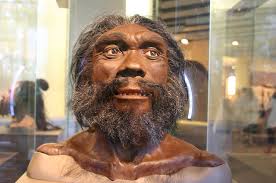
Male Erectus -
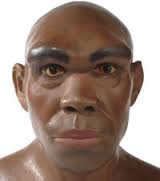
Neanderthal vs Us -
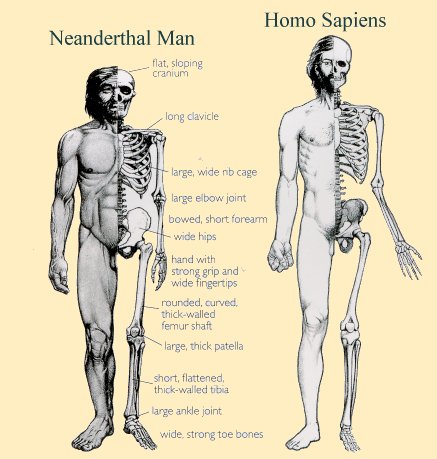
Comparison 1 -
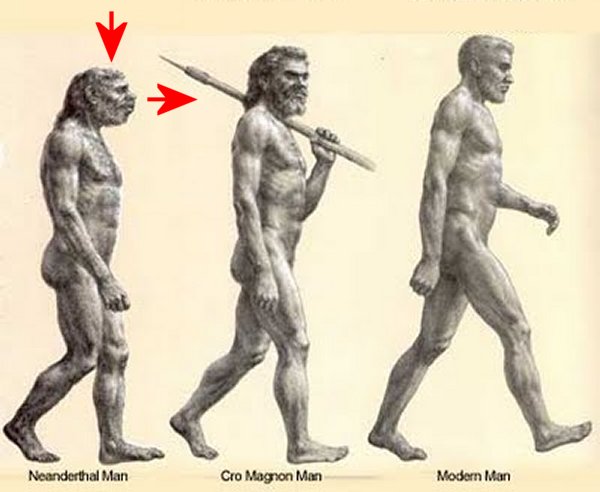
Comparison 2 -

Comparison 3 -
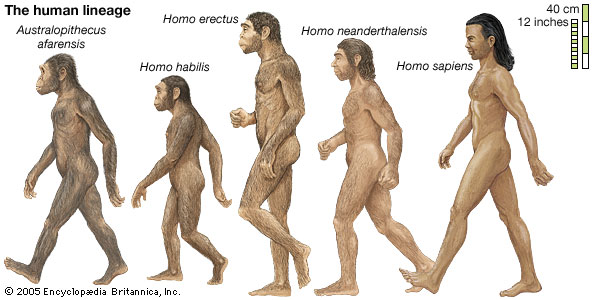
edit on 19-3-2015 by peter vlar because: (no reason given)
a reply to: peter vlar
Hmm, hang on you're right. Lascaux isn't old enough for Neanderthals. I love archeoastrology, I was getting ahead of myself there.
A couple of those Neanderthals don't look too bad, really. A moonlit night, plenty of fermented fruit, the sound of boneflute...fair enough, Sapiens!
I have learned an incredible amount about Neanderthals in the last few days. I'm very fond of the Bronze Age, but I'm starting to love these Neanderthal cousins we had. You probably read this at the time but I'm including it anyway (not least to shoehorn my astronomy hypothesis into this thread):
New Scientist article
My point being only that sailors need to know stars, even for short journeys. It takes a wee while to travel 40km by boat, so you'd want to know where you were should the weather turn. The article goes on to say that it's possible that Homo Erectus sailed too.
Yes, can you imagine the next ten years? Our kids will know this stuff as their baseline, and will search from there with all this knowledge already in place. When I was at school, we were taught that cavemen grunted at each other and lived until they were 20. God knows which book they got that from. For that matter, we were taught that the Picts behaved like that too, but I won't start down that bitter, bitter road here!
Hmm, hang on you're right. Lascaux isn't old enough for Neanderthals. I love archeoastrology, I was getting ahead of myself there.
A couple of those Neanderthals don't look too bad, really. A moonlit night, plenty of fermented fruit, the sound of boneflute...fair enough, Sapiens!
I have learned an incredible amount about Neanderthals in the last few days. I'm very fond of the Bronze Age, but I'm starting to love these Neanderthal cousins we had. You probably read this at the time but I'm including it anyway (not least to shoehorn my astronomy hypothesis into this thread):
IT LOOKS like Neanderthals may have beaten modern humans to the seas. Growing evidence suggests our extinct cousins criss-crossed the Mediterranean in boats from 100,000 years ago - though not everyone is convinced they weren't just good swimmers.
Neanderthals lived around the Mediterranean from 300,000 years ago. Their distinctive "Mousterian" stone tools are found on the Greek mainland and, intriguingly, have also been found on the Greek islands of Lefkada, Kefalonia and Zakynthos. That could be explained in two ways: either the islands weren't islands at the time, or our distant cousins crossed the water somehow. Now, George Ferentinos of the University of Patras in Greece says we can rule out the former. The islands, he says, have been cut off from the mainland for as long as the tools have been on them.
Ferentinos compiled data that showed sea levels were 120 metres lower 100,000 years ago, because water was locked up in Earth's larger ice caps. But the seabed off Greece today drops down to around 300 metres, meaning that when Neanderthals were in the region, the sea would have been at least 180 metres deep...
Strasser agrees Neanderthals were seafaring long before modern humans, in the Mediterranean at least. He thinks early hominins made much more use of the sea than anyone suspects, and may have used the seas as a highway, rather than seeing them as a barrier. But the details remain lost in history. Any craft were presumably made from wood, so rotted away long ago. The oldest known Mediterranean boat, a dugout canoe from Lake Bracciano in Italy, is just 7000 years old. Ferentinos speculates that Neanderthals may have made something similar.
(Journal of Archaeological Science, DOI: 10.1016/j.jas.2012.01.032).
New Scientist article
My point being only that sailors need to know stars, even for short journeys. It takes a wee while to travel 40km by boat, so you'd want to know where you were should the weather turn. The article goes on to say that it's possible that Homo Erectus sailed too.
Yes, can you imagine the next ten years? Our kids will know this stuff as their baseline, and will search from there with all this knowledge already in place. When I was at school, we were taught that cavemen grunted at each other and lived until they were 20. God knows which book they got that from. For that matter, we were taught that the Picts behaved like that too, but I won't start down that bitter, bitter road here!
a reply to: beansidhe
Im surprised that there was no mention of mousterian tools or Neanderthal remains on Malta or Crete. The only way for them to have reached those islands would be by sea and I agree, they would have had to use stars and constellations as markers when sailing at night, even if walking on dry land they likely would have used the stars as sign posts to maintain their course if traveling by night.
As for H. Erectus, i think that they very definitely had the ability to traverse open seas. In 2008 Russian researchers were working on the island Socotra where they foind primitive stome tools. What clinches the seafaring abilities of Erectus isthe age of the artifacts and the distance from the main land.
The tools have been dated to between 500KYA amd 1 million years old which is smack dab in the middle of the reign of Erectus and the island is a whopping 150 miles off the horn of Africa(Ethiopia,Somalia, Eritrea) and 240 miles off the coast of Yemen. Between this find and the evidence that in addition to Neanderthal, Erectus also made their way to Crete. These finds destroy the old thought processes insinuating that the farther back in time we look, the less intelligent the hominids were. This obviously is not the case as the construction of sea worthy vessels capable of traversing the aforementioned distances is no joke or walk in the park. It required not just intelligence but the ability to conceive abstract thought in order to imagine what may lie over the horizon and the balls to venture out and see what it may be.
Im glad to see youve found a new fondness for Neanderthal. They are my favorite hominid by far. Its amazing that omly a few decades ago many people still considered them to be thugish brutes while today they are recognized as imtelligent, creative and capable people on par with AMH. So much so that we were mating with them and in so,e instances living and working with them as well as dyimg amd being buried with them. They were capable of performing life saving surgical procedures such as amputations and trepaning as is demonstrated at a site in Siberia.
Im a little all over the place right now as Im working on about 2 hours of sleep but I want to go back to
to the stars... Neanderthal were aroind as a distinct species for a half a millin years whereas Homo Sapiens Sapiens have been out of Africa less than 100kya so they had plenty of time to watch the nighttime skies and learn at least some basic patterns of the movement of the stars and constellations and possibly utilizing the stars positions in some of their cave art to chart it for future reference. The possibilities are endless as was their imtelligence.
Im surprised that there was no mention of mousterian tools or Neanderthal remains on Malta or Crete. The only way for them to have reached those islands would be by sea and I agree, they would have had to use stars and constellations as markers when sailing at night, even if walking on dry land they likely would have used the stars as sign posts to maintain their course if traveling by night.
As for H. Erectus, i think that they very definitely had the ability to traverse open seas. In 2008 Russian researchers were working on the island Socotra where they foind primitive stome tools. What clinches the seafaring abilities of Erectus isthe age of the artifacts and the distance from the main land.
The tools have been dated to between 500KYA amd 1 million years old which is smack dab in the middle of the reign of Erectus and the island is a whopping 150 miles off the horn of Africa(Ethiopia,Somalia, Eritrea) and 240 miles off the coast of Yemen. Between this find and the evidence that in addition to Neanderthal, Erectus also made their way to Crete. These finds destroy the old thought processes insinuating that the farther back in time we look, the less intelligent the hominids were. This obviously is not the case as the construction of sea worthy vessels capable of traversing the aforementioned distances is no joke or walk in the park. It required not just intelligence but the ability to conceive abstract thought in order to imagine what may lie over the horizon and the balls to venture out and see what it may be.
Im glad to see youve found a new fondness for Neanderthal. They are my favorite hominid by far. Its amazing that omly a few decades ago many people still considered them to be thugish brutes while today they are recognized as imtelligent, creative and capable people on par with AMH. So much so that we were mating with them and in so,e instances living and working with them as well as dyimg amd being buried with them. They were capable of performing life saving surgical procedures such as amputations and trepaning as is demonstrated at a site in Siberia.
Im a little all over the place right now as Im working on about 2 hours of sleep but I want to go back to
to the stars... Neanderthal were aroind as a distinct species for a half a millin years whereas Homo Sapiens Sapiens have been out of Africa less than 100kya so they had plenty of time to watch the nighttime skies and learn at least some basic patterns of the movement of the stars and constellations and possibly utilizing the stars positions in some of their cave art to chart it for future reference. The possibilities are endless as was their imtelligence.
a reply to: peter vlar
Wow! 150 miles. You need to organise water, fishing lines, probably a crew - there's no way they could have done that without having language, no way. That requires a pretty complex series of sequential thoughts and for that I am almost certain you would need an inner dialogue.
I am getting very fond of them, they're quite exciting! I'm going to go and look at some of their rock art (online, unfortunately) to get some star inspiration. They must have seen meteors, comets, eclipses the same as us and it would be good to see if they might have recorded it.
B x
The tools have been dated to between 500KYA amd 1 million years old which is smack dab in the middle of the reign of Erectus and the island is a whopping 150 miles off the horn of Africa(Ethiopia,Somalia, Eritrea) and 240 miles off the coast of Yemen....It required not just intelligence but the ability to conceive abstract thought in order to imagine what may lie over the horizon and the balls to venture out and see what it may be.
Wow! 150 miles. You need to organise water, fishing lines, probably a crew - there's no way they could have done that without having language, no way. That requires a pretty complex series of sequential thoughts and for that I am almost certain you would need an inner dialogue.
I am getting very fond of them, they're quite exciting! I'm going to go and look at some of their rock art (online, unfortunately) to get some star inspiration. They must have seen meteors, comets, eclipses the same as us and it would be good to see if they might have recorded it.
B x
a reply to: beansidhe
Na ha! This is from La Ferrassie Caves, in south west France, 60,000 BC:
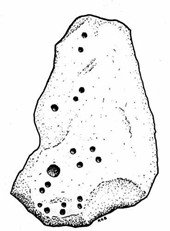
La Ferrassie Cupules
It could be anything, I realise that. But it's very similar to later 'star maps', seen on the cup and ring stones from the Bronze Age.
This is the Cochno Stone (or Druid's Stone), not too far away from me:
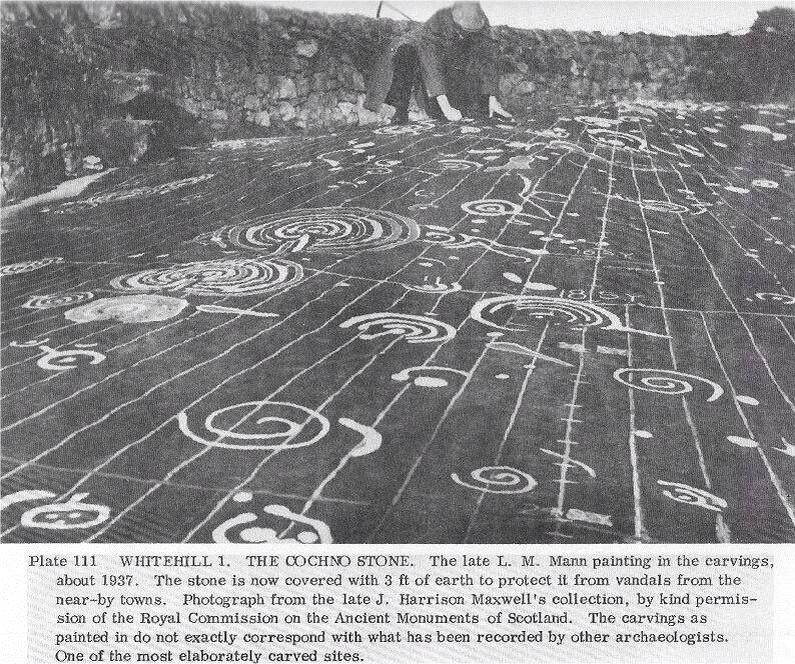
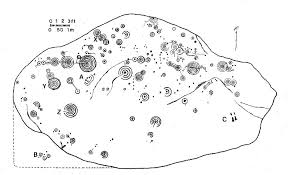
The Scotsman
Obviously the time difference is massive, but just thought I'd put it out there since it reminded me of this immediately.
Na ha! This is from La Ferrassie Caves, in south west France, 60,000 BC:

La Ferrassie Cupules
It could be anything, I realise that. But it's very similar to later 'star maps', seen on the cup and ring stones from the Bronze Age.
This is the Cochno Stone (or Druid's Stone), not too far away from me:


The Scotsman
Obviously the time difference is massive, but just thought I'd put it out there since it reminded me of this immediately.
edit on 20-3-2015 by
beansidhe because: sp
originally posted by: peter vlar
Female Neanderthal-
A few suspicious mushies and some fermented Birch sap, and i probably would.
new topics
-
Remember These Attacks When President Trump 2.0 Vengeance-Retribution Commences.
2024 Elections: 3 minutes ago -
Predicting The Future: The Satanic Temple v. Florida
Conspiracies in Religions: 11 minutes ago -
WF Killer Patents & Secret Science Vol. 1 | Free Energy & Anti-Gravity Cover-Ups
General Conspiracies: 2 hours ago -
Hurt my hip; should I go see a Doctor
General Chit Chat: 3 hours ago -
Israel attacking Iran again.
Middle East Issues: 4 hours ago -
Michigan school district cancels lesson on gender identity and pronouns after backlash
Education and Media: 4 hours ago -
When an Angel gets his or her wings
Religion, Faith, And Theology: 5 hours ago -
Comparing the theology of Paul and Hebrews
Religion, Faith, And Theology: 5 hours ago -
Pentagon acknowledges secret UFO project, the Kona Blue program | Vargas Reports
Aliens and UFOs: 6 hours ago -
Boston Dynamics say Farewell to Atlas
Science & Technology: 7 hours ago
top topics
-
The Democrats Take Control the House - Look what happened while you were sleeping
US Political Madness: 10 hours ago, 18 flags -
In an Historic First, In N Out Burger Permanently Closes a Location
Mainstream News: 12 hours ago, 16 flags -
A man of the people
Medical Issues & Conspiracies: 17 hours ago, 11 flags -
Man sets himself on fire outside Donald Trump trial
Mainstream News: 9 hours ago, 9 flags -
Biden says little kids flip him the bird all the time.
Politicians & People: 9 hours ago, 9 flags -
Pentagon acknowledges secret UFO project, the Kona Blue program | Vargas Reports
Aliens and UFOs: 6 hours ago, 6 flags -
Michigan school district cancels lesson on gender identity and pronouns after backlash
Education and Media: 4 hours ago, 6 flags -
WF Killer Patents & Secret Science Vol. 1 | Free Energy & Anti-Gravity Cover-Ups
General Conspiracies: 2 hours ago, 6 flags -
Israel attacking Iran again.
Middle East Issues: 4 hours ago, 5 flags -
Boston Dynamics say Farewell to Atlas
Science & Technology: 7 hours ago, 4 flags
active topics
-
Predicting The Future: The Satanic Temple v. Florida
Conspiracies in Religions • 2 • : budzprime69 -
Remember These Attacks When President Trump 2.0 Vengeance-Retribution Commences.
2024 Elections • 0 • : WeMustCare -
The New, New ATS Members Photos thread. Part 3.
Members • 1653 • : zosimov -
A man of the people
Medical Issues & Conspiracies • 15 • : PrivateAngel -
Israel attacking Iran again.
Middle East Issues • 27 • : KrustyKrab -
I hate dreaming
Rant • 7 • : TheMichiganSwampBuck -
MULTIPLE SKYMASTER MESSAGES GOING OUT
World War Three • 53 • : Zaphod58 -
Michigan school district cancels lesson on gender identity and pronouns after backlash
Education and Media • 8 • : TheMichiganSwampBuck -
I Guess Cloud Seeding Works
Fragile Earth • 29 • : Justoneman -
Man sets himself on fire outside Donald Trump trial
Mainstream News • 40 • : Vermilion

